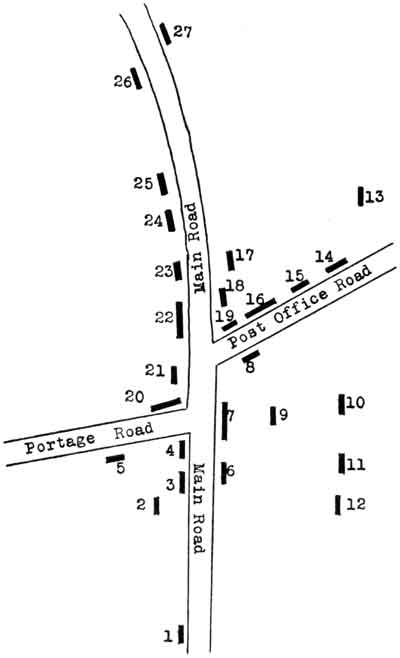Manitoba Pageant, January 1958, Volume 3, Number 2
|
The accompanying map-plan shows Winnipeg's famed Portage and Main district as it was in 1869. It has been reproduced from a book written by Alexander Begg and Walter Nursey titled Ten Years in Winnipeg. The year 1869, you will remember, was marked by the beginning of the Red River Resistance led by Louis Riel and the following year was to see Manitoba admitted as a province to the Dominion of Canada. The authors of the book mentioned above had this to say, however, about life in Winnipeg in 1869: "We had no bank, no insurance office, no lawyers, only one doctor, no City Council, only one policeman, no taxes — nothing but freedom and, though lacking several other so called advantages of civilization, we were, to say the least of it, tolerably virtuous and unmistakably happy." As you note the changes that have taken place, make a date to visit at least two points which are still distinguishable: Fort Garry Gate, across from the C.N.R. depot and the site of the first Manitoba Legislative Building; a plaque on the Banque Canadienne Nationale, 433 Main St. North, marks this.

1. Fort Garry
2. Hudson's Bay Company Store
3. Wm. Drever's
4. Red Saloon
5. Holy Trinity Church
6. Brian Devlin's
7. Red River Hall and Block
8. O. Monchamp's
9. Garrett House
10. McDermott's house, occupied by Dawson Road overseers
11. McDermott's house, afterwards used as a Custom House
12. Wm. Drever's house, now used as a convent
13. McDermott's Mill
14. A. McDermott's, senr., residence
15. Engine House
16. Post Office Block
17. A. G. B. Bannatyne's residence, afterwards used as Parliament Buildings
18. & 19. Bannatyne and Begg's store
20. Henry McKenny and Larsen's
21. Henry McKenny and Larsen's storehouse, afterwards used as a saloon by McIvor and McIntyre
22. Emmerling Hotel, afterwards Davis House
23. John Higgins'
24. W. H. Lyon's
25. Henry Coture, the butcher
26. W. G. Fonseca's store
27. E. L. Barber's store
Page revised: 30 June 2009